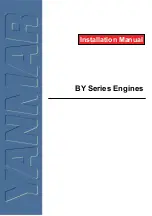
6.3
External fuel oil system
The design of the external fuel system may vary from ship to ship, but every system should
provide well cleaned fuel of correct viscosity and pressure to each engine. Temperature control
is required to maintain stable and correct viscosity of the fuel before the injection pumps (see
Technical data). Sufficient circulation through every engine connected to the same circuit must
be ensured in all operating conditions.
The fuel treatment system should comprise at least one settling tank and two separators.
Correct dimensioning of HFO separators is of greatest importance, and therefore the
recommendations of the separator manufacturer must be closely followed. Poorly centrifuged
fuel is harmful to the engine and a high content of water may also damage the fuel feed system.
Injection pumps generate pressure pulses into the fuel feed and return piping. The fuel pipes
between the feed unit and the engine must be properly clamped to rigid structures. The
distance between the fixing points should be at close distance next to the engine. See chapter
Piping design, treatment and installation.
A connection for compressed air should be provided before the engine, together with a drain
from the fuel return line to the clean leakage fuel or overflow tank. With this arrangement it is
possible to blow out fuel from the engine prior to maintenance work, to avoid spilling.
NOTE
In multiple engine installations, where several engines are connected to the same
fuel feed circuit, it must be possible to close the fuel supply and return lines
connected to the engine individually. This is a SOLAS requirement. It is further
stipulated that the means of isolation shall not affect the operation of the other
engines, and it shall be possible to close the fuel lines from a position that is not
rendered inaccessible due to fire on any of the engines.
6.3.1
Low sulphur operation
For newbuildings expected to operate purely within SECAs, fuel and lubricating oil filling,
storage, transfer, separation, and supply systems can in principle be arranged as on a traditional
HFO ship.
However, if intention is to operate on different fuel quailties inside and outside SECAs it is
beneficial to install double bunker tanks, settling tanks, service tanks and leak fuel tanks in
order to avoid mixing incompatible fuels. Also check if flexible lube oil systems is needed, in
order to avoid operation with high-sulphur fuel and too low lube oil BN.
6.3.2
Fuel heating requirements HFO
Heating is required for:
●
Bunker tanks, settling tanks, day tanks
●
Pipes (trace heating)
●
Separators
●
Fuel feeder/booster units
To enable pumping the temperature of bunker tanks must always be maintained 5...10°C
above the pour point, typically at 40...50°C. The heating coils can be designed for a temperature
of 60°C.
The tank heating capacity is determined by the heat loss from the bunker tank and the desired
temperature increase rate.
6-10
Wärtsilä 20 Product Guide - a13 - 6 September 2016
Wärtsilä 20 Product Guide
6. Fuel Oil System
Содержание WARTSILA 20
Страница 1: ...W RTSIL 20 PRODUCT GUIDE...
Страница 34: ...This page intentionally left blank...
Страница 42: ...This page intentionally left blank...
Страница 86: ...This page intentionally left blank...
Страница 92: ...This page intentionally left blank...
Страница 124: ...This page intentionally left blank...
Страница 140: ...This page intentionally left blank...
Страница 154: ...This page intentionally left blank...
Страница 160: ...This page intentionally left blank...
Страница 172: ...This page intentionally left blank...
Страница 175: ......
Страница 176: ......
Страница 177: ......
















































